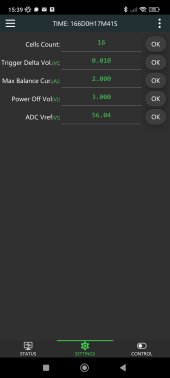BentleyJ
Solar Wizard
I did a few searches before posting but didn't find anything relevant. I'm using a JK-B2A24S Bluetooth balancer and the Start Balance Voltage setting is fixed at 4.20V and cannot be changed. This feature is obviously disabled since balancing occurs at all voltages when the slider is ON. I suspect its because the hardware and firmware are 3+ years old. Based on the documentation at JKBMS.com and older YT vids etc. I don't think that Start Voltage feature was available then. I know the newer BMS products with built in active balancing do have the feature.
I've been all over the Internet and there is no information available regarding this issue. Have sent an email to info@JKBMS.com and info@appbattery.com. Not expecting to get a reply.
Anyone have a similar experience or any comments/solutions? If I have to purchase new 2A balancer I suppose that's better then having to manually turn ON the balancer when the battery voltage reaches 54.4 during a charge cycle, then turn it OFF later.
I've been all over the Internet and there is no information available regarding this issue. Have sent an email to info@JKBMS.com and info@appbattery.com. Not expecting to get a reply.
Anyone have a similar experience or any comments/solutions? If I have to purchase new 2A balancer I suppose that's better then having to manually turn ON the balancer when the battery voltage reaches 54.4 during a charge cycle, then turn it OFF later.







